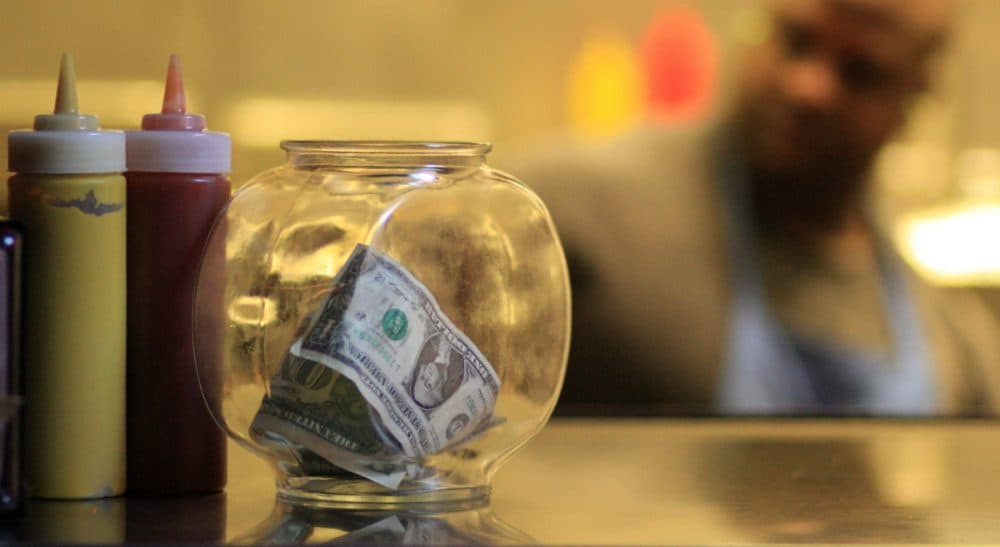Advertisement
The Tip Jar Of The Future

Operation Burrito Incognito came with a side of heartburn for Hillary Clinton recently when it was revealed that the only tip Chipotle employees got came from a reporter informing them that the Democratic presidential hopeful had bought a meal without them noticing.
Clinton left no gratuity. Well, almost Clinton: Her aide, Huma Abedin, actually paid the bill. Well, almost no tip: The bill was just over $20, and Abedin gave the cashier $21 and left without accepting change. Nothing was deposited into the tip jar, which sparked a round of criticism that Hillary is out of touch with the working class she purports to represent.
But I can relate to Hillary and/or Huma’s plight. How and when to tip in 2015 is, for me anyway, surprisingly still a work in progress.
Who am I tipping? I deal face to face with five or six people as my burrito makes its way down the assembly line.
The procedure remains simple in a sit-down restaurant. You get the check and leave the tip once the server leaves. But even that transaction is changing. In places that use point-of-sale technology, you have to make a decision when the waitperson is in your face.
Most waiters and waitresses work hard. My restaurant tips won’t put the server through grad school, but I try to be kind because I figure that he will appreciate the extra money more than I’ll miss it. Even if the food is awful, I tip no less than 20 percent, unless he's missing or hissing.
In a recent encounter with a waitress who swiped my card with a Square Register, I was given the standard options of tipping 15, 20 or 25 percent. My other choices were “no tip” or “custom,” which I declined because we both were in a hurry (and also because ugh, math!). I chose 25 percent because she was good. But what if she wasn’t? Would I have felt pressure to tip higher anyway because she was there, or just sign my name as Scrooge?
I understand the confusion at Chipotle. This is the company that released “The Scarecrow,” a brilliant animated movie railing against factory farming, and which just announced it was going GMO-free. It has a groovy ethos, even if you know the folks behind the counter aren’t sharing buffets with Warren Buffet.
I can walk in and out of McDonald’s, the punching bag for protests against low minimum wages, without concerning myself about tipping. But at Chipotle, I’m encouraged to leave a little extra even though I'm charged extra for guacamole. Who am I tipping? I deal face to face with five or six people as my burrito makes its way down the assembly line. I’m working as hard as they are as I loudly repeat my words — “What the hell is barbacoa?” — over the plastic cone of silence they work behind. I’ll still leave a buck or two and hope I’m in the ballpark, because I have no idea what the going rate ought to be. I also have no idea whether Chipotle employees make less than their McDonald’s brethren, but work for a company with better PR. I can only assume that the presence of a tip jar means that the workers are underpaid.
In its time before Fred the Baker, every Dunkin’ Donuts I visited had a sign that proudly proclaimed — almost demanded — “No Tipping.” That’s no longer the case. It’s never been the case at any Starbucks I’ve patronized. I’m unsure what constitutes a venti tip for a grande cup, though if the barista discusses race before I’ve had caffeine, I extract from the tip jar.
I feel as if I need an app or a cheat sheet to determine how much to leave behind, and to whom.
I recently had furniture delivered to my place. The two guys had to climb 34 steps. I tipped them well. I gave even more to the men who hauled up a stacked washer/dryer combo. One had to work upside down in a laundry closet that barely held the appliances, let alone a human trying to hook them up in the rear. I gave him extra even though he left shoe prints six feet up a freshly painted wall.
There are the usual services for which a tip is expected: cabbies, hairdressers, pizza deliverers (lots more for this guy.) But in recent years, tipping jars started to appear in places I hadn’t noticed before. How much is expected of me when I order take-out food and I’m the one doing the driving? The restaurant employees work hard, but so do many others who provide a service and don’t expect a tip, like plumbers, who could buy and sell me, or the supermarket deli person who invariably slices two ounces more than I asked for and expects me to be okay with it.
I feel as if I need an app or a cheat sheet to determine how much to leave behind, and to whom. In the meantime, I’ll gladly accept tips.

